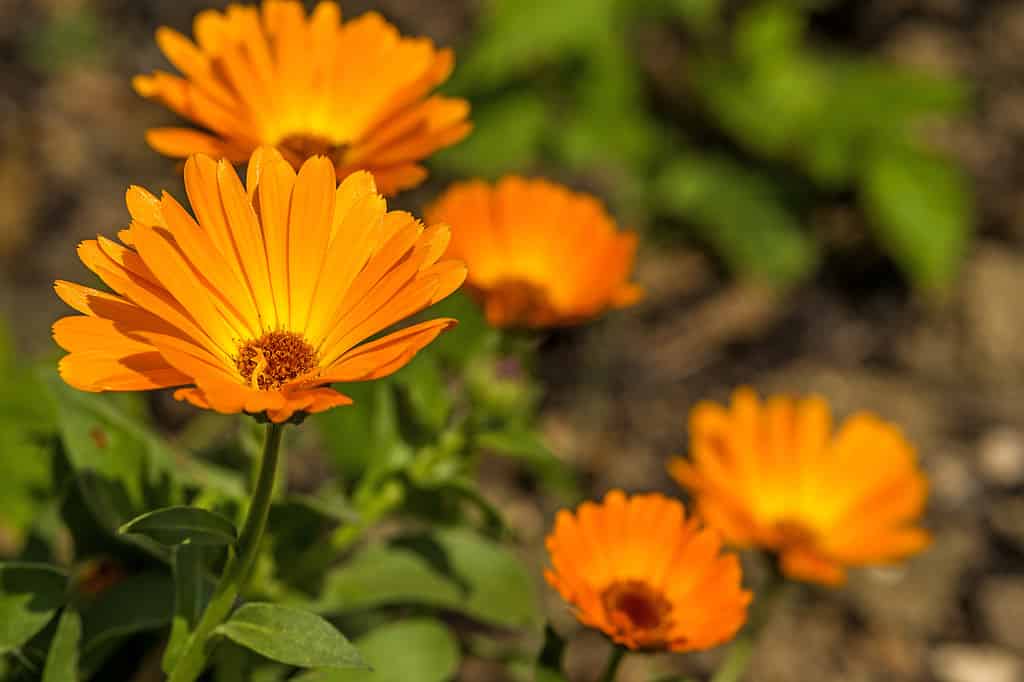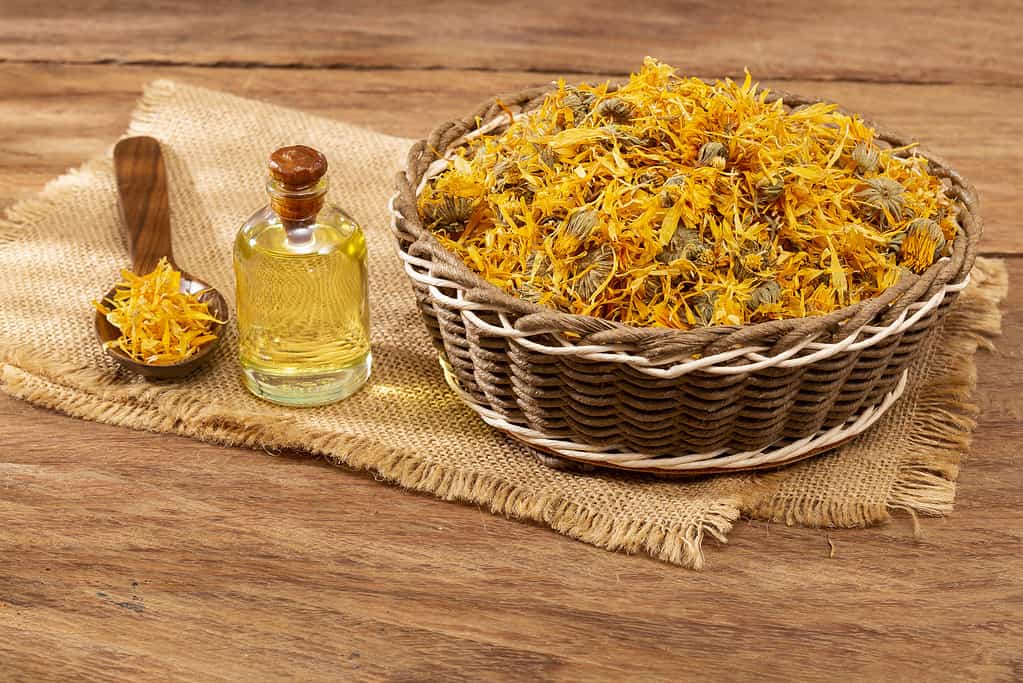A traditional cottage garden favorite, calendulas, often referred to as pot marigolds, are often used as companion plants to help attract pollinating beneficial insects. The blooms’ edible petals can be used as a colorful and eye-catching garnish on salads and other foods. Calendula has been used to treat skin conditions including rashes, wounds, and sores as well as to lessen discomfort and inflammation; they are known to have some pretty cool healing abilities in addition to being tasty and good-looking! Calendula petals are easy to harvest and can be used fresh or dried in teas and other foods.
Calendula is a hardy annual that can withstand some frost and is thus easy to grow for both novice and seasoned gardeners. In this guide, we’ll break down some important facts about the calendula plant and explain how you can start growing these beautiful flowers at home.
The Botanical Name and History of Calendula
Calendula, sometimes referred to as pot marigold, belongs to the genus Calendula and is classified as Calendula officinalis. It grows as an annual flower in garden beds and containers in cooler temperate zones, whilst it is a short-lived perennial in warmer climes. Calendula is distinct from common marigolds despite being known as the pot marigold. It does, however, resemble a daisy and belongs to the Asteraceae family, which also includes chrysanthemums and daisies. After the final frost, it is planted in the spring and develops rather fast, blossoming around eight weeks after sowing.
The gold blooms that blossomed during the Virgin Mary festivities in Renaissance times gave rise to the widespread name for pot marigold. Calendula was utilized in ancient Greek, Roman, Arabian, and Indian cultures as a medicinal herb and as a culinary, cosmetic, and fabric dye. These plants are now cultivated by gardeners for their bright blossoms and profusion of blooms. While having blooms that are most often seen in yellow, orange, and red variants, you can also find them with hints of pink and cream or even green.
Calendula comes in a wide range of varieties that are popular among gardeners. Gold and pink blossoms can be seen on the Pink Surprise calendula. The Prince cultivar thrives in hot areas and grows quite tall. Calendulas with green cores known as Greenheart Orange calendulas are prized by plant enthusiasts for their unique and distinctive appearance.

Calendulas (pictured) are harvested for their flower petals for use in food and medicine.
©iStock.com/HansJoachim
Climate and Hardiness Zone Requirements for Calendula
Calendulas can be grown in USDA hardiness zones two through 11. They are very cold-hardy plants. Unless you reside in hardiness zones nine to 11, where it can be grown as a perennial, calendula is typically an annual plant. They cannot handle extremely hot temperatures, though some varieties have been bred to handle hotter climates.
When to Grow Calendula
The best time to grow calendulas is when the threat of frost has passed in the early spring. However, this really depends on which hardiness zone you plan to grow your calendulas. Sow seeds indoors in the early spring and when the risk of frost has gone, repot or transfer the resulting robust seedlings. The colder months of late fall and spring are when calendula grows the best in regions with long scorching summers, like Arizona.
How to Grow Calendula
With seeds directly placed in the garden or in containers, calendula is very easy to grow for beginners. While calendulas can survive in unfavorable circumstances, they thrive in nutrient-rich soil. These plants don’t require a lot of water or fertilizer to grow once they are established. Although calendula is a full-sun plant, it doesn’t like scorching heat and can begin to wilt under such conditions.
Calendula grows nicely in pots and as a bedding annual at the start of a border display. Grow calendula alongside your tomatoes, bean poles, and other crops in a greenhouse and vegetable patch to draw pollinating insects. They grow best when started from seed and planted in a flowering area. In patches or rows, scatter your calendula seeds thinly and cover them gently with soil. Seedlings should be spaced four to six inches apart. To put out later, you can either buy them as potted plants or sow seeds in seedling containers indoors. Calendula can also be used in container displays and bedding.
Young plants should be pruned down to encourage more compact, bushy growth and to avoid becoming lanky or leggy. The old blooms should be deadheaded to promote reblooming.
Soil and Fertilizer Requirements for Calendula
Calendula requires organically rich, well-drained soil, just as the majority of other members of the daisy family do. The roots can eventually rot in heavy, moist soil. While it can survive a variety of soil pHs, this plant likes slightly acidic to neutral soil with a pH between 6.3 to 7.0.
Calendula doesn’t require a lot of fertilizer, either. It doesn’t need any feeding at all if it is grown in rich garden soil. A balanced, water-soluble fertilizer can sometimes be necessary to nourish less-than-ideal soils, but over-fertilization might result in unattractive, spindly plants. Container plants need fertilizer that has been diluted and balanced every month during the spring and summer.
Water Requirements for Calendula
Until your calendula plants are established, water them often. Occasional sporadic watering is necessary for mature plants to survive. Avoid giving these plants excessive water, as root rot can kill them quickly.
Temperature and Humidity Requirements for Calendula
In very hot climates, calendula may disappear before the end of the summer since it likes mild summer temperatures. These plants will likewise perish in severe cold. If you anticipate a day or two of frost, you can cover the plants with a frost blanket at night and remove it in the morning when the sun warms the air. For some added protection, three to four inches of mulch will shield the plants from the cold.
Sunlight Requirements for Calendula
While calendula often thrives in full sun, if it doesn’t get some afternoon shade during the warmest months, it can wither and wilt.
Pot Requirements for Calendula
Calendula plants can grow quite well indoors in pots. The majority of calendula varieties, especially shorter cultivars, do well in pots. Use any organic potting soil that drains well, or combine garden soil and compost in equal parts to create your own combination. As this plant dislikes being excessively moist, make sure the pot has lots of drainage holes. It is also recommended to use clay-based pots, as they are porous and can help pull out the moisture in the soil. Remember, calendulas can die from root rot, so it is vital to ensure it drains properly. Calendulas that are kept in pots require regular fertilizer feedings with a balanced fertilizer as well.
How to Harvest Calendulas
Calendula flowers and leaves can be used as edible flowers in salads and other cuisines, either fresh or dried, despite some people finding the spicy flavor a little harsh. A deep yellow dye can also be made from the petals. Early in the morning, once the dew has dried, gather your calendula blossoms. They should only be harvested when the flowers have opened completely. The cut flower heads should be put out on a screen in a dry, shaded area to dry the blooms. When they are thoroughly dry, turn them regularly, then store them in canning jars until you’re ready to use them.

The flowers of calendulas (pictured) can be harvested and stored for months with the proper techniques.
©iStock.com/Gonzalo Calle Asprilla
Diseases and Pests to Watch Out for
This lovely plant attracts a good number of curious insects. However, not all of them are pests! Blister beetles, spider mites, thistle butterfly larvae, slugs, snails, flea beetles, cucumber beetles, and, most often, whiteflies and aphids are some pests that you might notice eating your calendula. Because of these common pests, you might be wondering why the calendula is often labeled as a companion plant or trap crop. That’s because a wide range of other advantageous and beneficial insects are attracted to this cheery blossom. A few include bumblebees, hoverflies, ladybugs, butterflies, and more. If you notice insects that are damaging your calendula plants, give them a good spray with a hose. We do not recommend using pesticides on these plants, as they could harm the beneficial insects you will want in your garden. Just as well, if you are using calendula as a culinary ingredient, you should not use insecticides on it.
Slugs and snails can be particularly damaging to calendulas, especially when they are still young. It’s crucial to keep the soil and areas around your garden free of trash and debris to prevent slug and snail damage.
There are not many illnesses that target calendulas, other than fungal infections. Use fungicides, keep up proper plant hygiene, and distance plants enough apart to prevent illnesses in calendula. That extra space can improve airflow and prevent the growth of spores. Calendulas with diseases can be managed in part by rotating crops. Make sure the soil has sufficient drainage as well. To stop an illness from spreading, get rid of diseased plants, and hydrate the plants’ bases. Regular weeding and pruning can also help.
How to Propagate Calendulas
If you want to propagate your calendula plants, you’re in luck; you really don’t have to do anything! The calendula plant prefers to self-seed when left alone. The next year, avoid tilling the soil and you should discover additional plants near the originals within a few months. To save seeds for planting in another area come spring, you can also gather and store them. Make sure the seedheads are completely developed on the plant before harvesting them. They will turn brown and papery as they mature. Take them out of the plant and place them indoors on a piece of paper to dry for a few days. After the seeds are dry, detach them from the seedhead and put them in a fresh, clean envelope. Simply set the seeds where you want them to bloom the next year after keeping them in a cool, dry area, like the refrigerator or a cabinet.
Calendulas are fascinating plants that can provide vibrant golden color to your garden year after year. If you don’t have much use for calendulas outside of their aesthetic appeal, they are still worth planting in the garden as a companion plant and for attracting beneficial pollinators such as bumblebees and butterflies. What’s not to love about the sunny calendula?
The photo featured at the top of this post is © Yulia_B/Shutterstock.com
FAQs (Frequently Asked Questions)
Does calendula come back every year?
Calendula will reseed on its own and in most cases will come back each year.
Where should I plant my calendula plant?
Calendula should be planted in an area where it can receive full sun and very well-draining soil.
When is the best time to plant calendula?
Plant calendula seeds in spring after frost has passed.
Thank you for reading! Have some feedback for us? Contact the AZ Animals editorial team.






